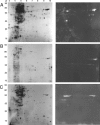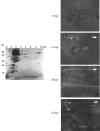Identification of Staphylococcus aureus proteins recognized by the antibody-mediated immune response to a biofilm infection
- PMID: 16714572
- PMCID: PMC1479260
- DOI: 10.1128/IAI.00392-06
Identification of Staphylococcus aureus proteins recognized by the antibody-mediated immune response to a biofilm infection
Abstract
Staphylococcus aureus causes persistent, recurrent infections (e.g., osteomyelitis) by forming biofilms. To survey the antibody-mediated immune response and identify those proteins that are immunogenic in an S. aureus biofilm infection, the tibias of rabbits were infected with methicillin-resistant S. aureus to produce chronic osteomyelitis. Sera were collected prior to infection and at 14, 28, and 42 days postinfection. The sera were used to perform Western blot assays on total protein from biofilm grown in vitro and separated by two-dimensional gel electrophoresis. Those proteins recognized by host antibodies in the harvested sera were identified via matrix-assisted laser desorption ionization-time of flight analysis. Using protein from mechanically disrupted total and fractionated biofilm protein samples, we identified 26 and 22 immunogens, respectively. These included a cell surface-associated beta-lactamase, lipoprotein, lipase, autolysin, and an ABC transporter lipoprotein. Studies were also performed using microarray analyses and confirmed the biofilm-specific up-regulation of most of these genes. Therefore, although the biofilm antigens are recognized by the immune system, the biofilm infection can persist. However, these proteins, when delivered as vaccines, may be important in directing the immune system toward an early and effective antibody-mediated response to prevent chronic S. aureus infections. Previous works have identified S. aureus proteins that are immunogenic during acute infections, such as sepsis. However, this is the first work to identify these immunogens during chronic S. aureus biofilm infections and to simultaneously show the global relationship between the antigens expressed during an in vivo infection and the corresponding in vitro transcriptomic and proteomic gene expression levels.
Figures




References
-
- Anborgh, P. H., S. Okamura, and A. Parmeggiani. 2004. Effects of the antibiotic pulvomycin on the elongation factor Tu-dependent reactions. Comparison with other antibiotics. Biochemistry 43:15550-15556. - PubMed
-
- Assenmacher, M., M. Lohning, A. Scheffold, R. A. Manz, J. Schmitz, and A. Radbruch. 1998. Sequential production of IL-2, IFN-gamma and IL-10 by individual staphylococcal enterotoxin B-activated T helper lymphocytes. Eur. J. Immunol. 28:1534-1543. - PubMed
Publication types
MeSH terms
Substances
Grants and funding
LinkOut - more resources
Full Text Sources
Other Literature Sources
Medical

